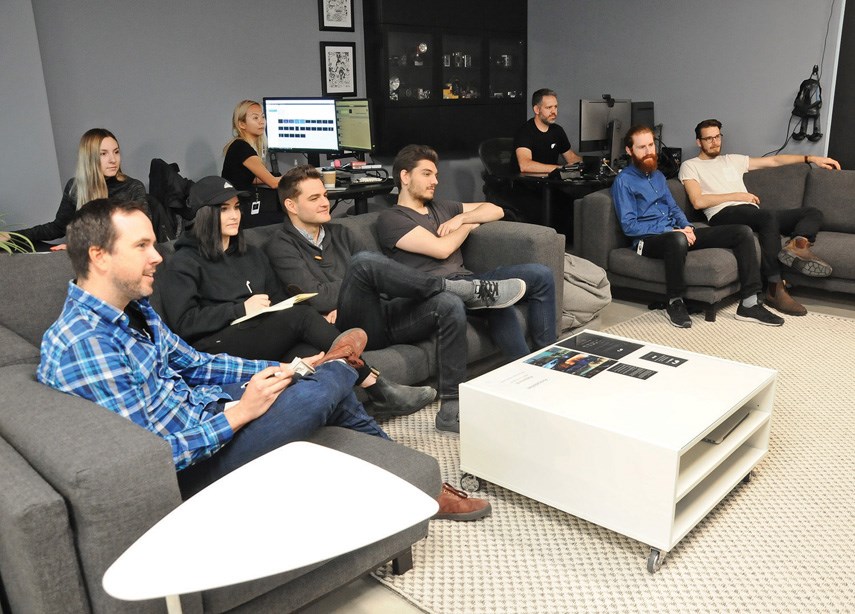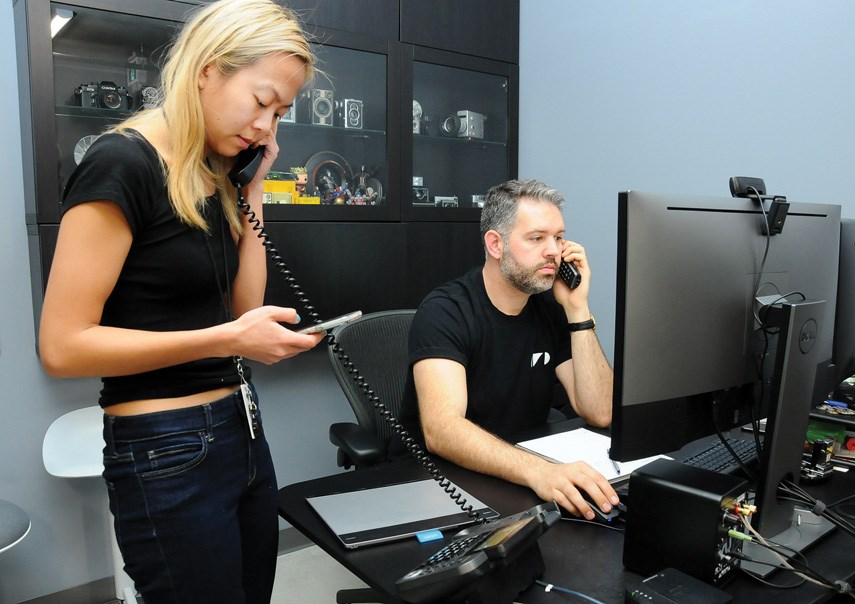A visual effects studio may be the one place where displaying copious costumes, fake weapons, and eccentric props makes for an appropriate workplace environment.
“We have a lot of the props that we’re digitally recreating, so people will be modeling those weapons or those props and then we’ll be rendering and compositing them in. We’ll have those props from set be at our office,” explains Chris van Dyck, founder of CVD VFX.
The North Vancouver-based full-service visual effects studio is celebrating its third anniversary this week – and third month being on the North Shore after being based in Vancouver since 2015.
“A lot of our staff are North Vancouver and we wanted more space as we’re growing. It just seemed like a logical step to bring it over here,” he says, adding that CVD VFX employs about 15 people with room to grow.
And while the company is now based on the North Shore, the worlds van Dyck’s staff help to digitally create, recreate, or enhance extend far beyond local shorelines.
A worn-town Afghanistan, a residential school in the 1970s, and even a futuristic Wild West-type amusement park are just a sampling of the television and feature film projects the company has had a hand in enhancing and faithfully reimagining using digital magic.
In the recent Chris Hemsworth-starring war drama 12 Strong, van Dyck explains that careful manipulation of visual effects allowed pros to take small scenes and turn them into big screens.
“We were tasked with building out an army of soldiers,” he says nonchalantly about CVD VFX’s involvement with the production. “We were given a handful of elements of soldiers on a green screen and populated them out to look like 500 soldiers – and added explosions.”
But when it comes to CVD VFX’s involvement in the second season of HBO’s hit futuristic drama Westworld, van Dyck’s lips are sealed.
“That we can’t talk about unfortunately because it still hasn’t been aired,” he says.
There has to be an air of secrecy about some of CVD VFX’s projects, van Dyck adds – in many cases, the company is providing or has provided visual effects services for some of the biggest intellectual properties in production, including Netflix’s A Series of Unfortunate Events and the galaxy-hopping video game Mass Effect. Ensuring that spoilers don’t get out, he says, is of the utmost importance.
He’s been in the industry for more than 15 years, prompted to first learn more about visual effects after pondering: “‘Hey, is there Photoshop for video?’”
But while he set out to learn the craft, he didn’t know it would become his life’s vocation until later.
“I thought it was maybe more of a skill that I was learning, not necessarily a career that I’d be entering. I got really fortunate that it’s become such a hotbed here in Vancouver,” he says.
Early on in Vancouver, he explains, he was mainly involved in episodic TV work, before heading to Australia and then San Francisco to work on feature films.

CVD VFX’s specialty is compositing and stylization, which van Dyck describes as integrating multiple layers – either footage or items rendered by the company or filmed out in the real world – on top of one another.
“If you’re going to be adding a helicopter, it might be a 3D-rendered helicopter and then we’ll composit it into the shot,” he says. “It’s enhancing the mood and creating the style through various techniques that are true to what a camera would do, but we’re digitally recreating those features, like adding flares and different attributes like that.”
One of the biggest projects the company has undertaken so far was last year’s Indian Horse, a film that follows a First Nations boy as he experiences and survives residential school during the 1970s, eventually becoming a star hockey player.
Working on a project like Indian Horse that explores heavy subject matter and doesn’t require digital effects of a fantastical or explosive nature allowed van Dyck and his team to focus specifically on creating an authentic mood.
“It has to be real,” he says. “There’s no style or fantasy involved, so we’re not really creating surreal palettes or anything like that. It’s more about us saying, ‘Hey, how do we make this town look like it was 50 years ago?’” And then us actually doing that research and taking the time and just matching that.”
The team used digital effects to accentuate the beauty of a lake, make some old things look new again, and vice versa. They used their skills to help take the audience on a journey through Canada’s recent past, showcasing both the tragedy and hopefulness therein.
“A lot of our artists feel like it was the best film that they’ve worked on. That just means a lot.”



